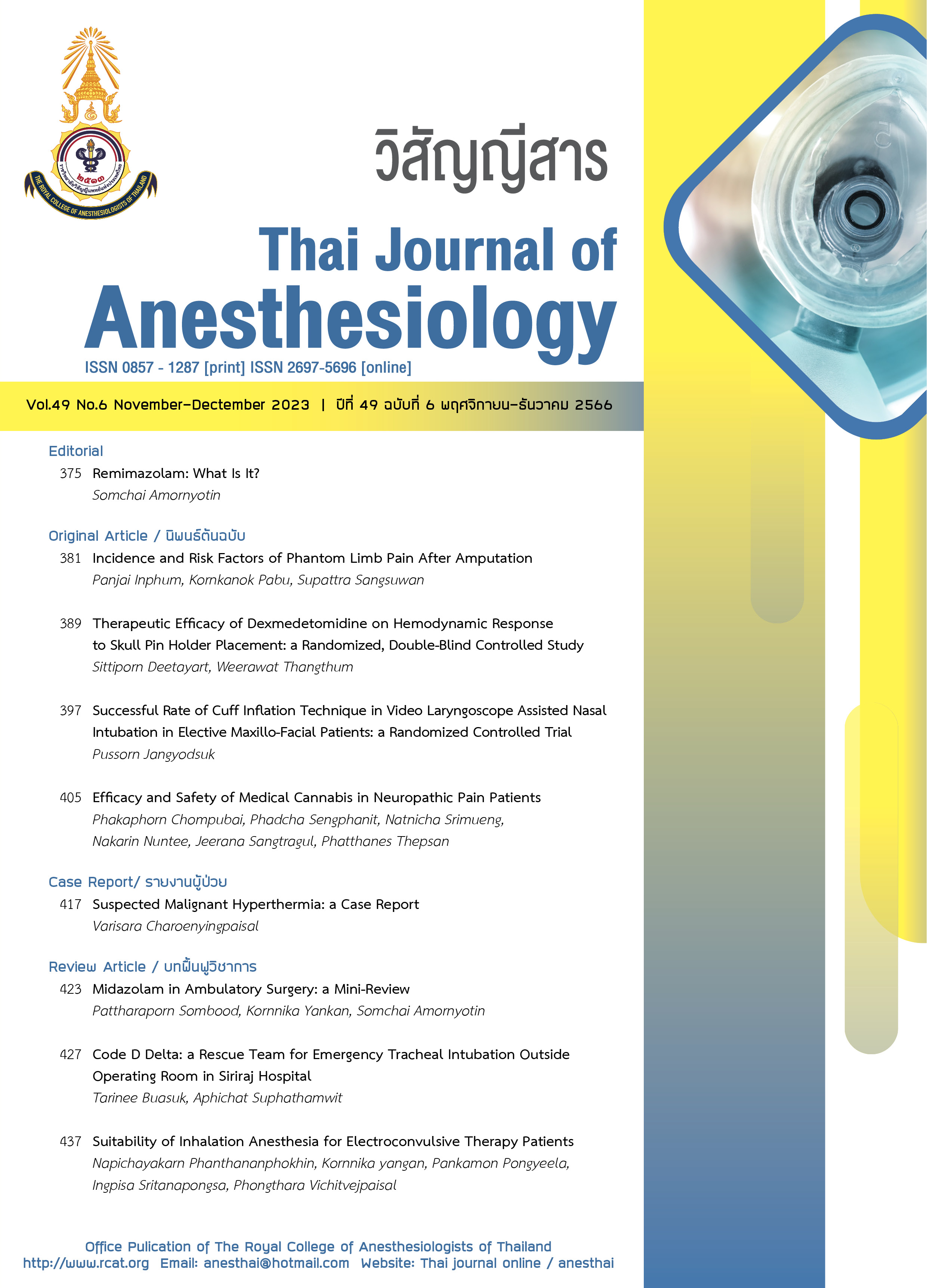Suspected Malignant Hyperthermia: a Case Report
Main Article Content
Abstract
We described a patient who developed probable malignant hyperthermia after receiving succinylcholine and sevoflurane. An explore-laparotomy for a right ovarian cystectomy was performed under general anesthesia on a 30-year-old Thai woman who had never previously had anesthesia. She developed tachycardia after receiving succinylcholine and sevoflurane, as well as an unexpected increase in ETCO2 and body temperature. Respiratory and metabolic acidosis was also evident. Rhabdomyolysis was suspected due to dark brownish urine and apparently high creatine phosphokinase. The clinical presentation was used to make a diagnosis of malignant hyperthermia. This patient received supportive and symptomatic care without the use of dantrolene. Finally, the outcome was satisfying since it was rapidly recognized and handled.
Article Details

This work is licensed under a Creative Commons Attribution-NonCommercial-NoDerivatives 4.0 International License.
References
ราชวิทยาลัยวิสัญญีแพทย์แห่งประเทศไทย. แนวทางเวชปฏิบัติสำหรับการดูแลผู้ป่วยกลุ่มเสี่ยงต่อ Malignant hyperthermia และผู้ป่วยที่มีอาการของ Malignant hyperthermia. ราชวิทยาลัยวิสัญญีแพทย์แห่งประเทศไทย; 2562 [Available from: https://www.rcat.org/]
Kaur H, Katyal N, Yelam A, Kumar K, Srivastava H, Govindarajan R. Malignant hyperthermia. Mo Med. 2019;116:154-9.
Figueroa L, Kraeva N, Manno C, et al. Distinct pathophysiological characteristics in developing muscle from patients susceptible to malignant hyperthermia. Br J Anaesth. 2023;131:47-55.
Litman RS, Griggs SM, Dowling JJ, Riazi S. Malignant hyperthermia susceptibility and related diseases. Anesthesiology. 2018;128:159-67.
Riazi S, Kraeva N, Hopkins PM. Malignant hyperthermia in the post-genomics era: new perspectives on an old concept. Anesthesiology. 2018;128:168-80.
Hopkins PM, Girard T, Dalay S, et al. Malignant hyperthermia 2020: guideline from the Association of Anaesthetists. Anaesthesia. 2021;76:655-64.
Ellinas H, Albrecht MA. Malignant hyperthermia update. Anesthesiol Clin. 2020;38:165-81.
Laha S, Giri PP, Saha A, Gupta PP, De A. Life-threatening episodes of malignant hyperthermia following halothane anesthesia in three children: a case series and review of literature. Indian J Crit Care Med. 2019;23:47-50.
Pulnitiporn A, Charuluxananan S, Inphum P, Kitsampanwong W. Malignant hyperthermia: a case report in Thai Anesthesia Incidents Study (THAI Study). J Med Assoc Thai. 2005;88(Suppl7):S149-52.
Charuluxananan S, Punjasawadwong Y, Suraseranivongse S, et al. The Thai Anesthesia Incidents Study (THAI Study) of anesthetic outcomes: II. Anesthetic profiles and adverse events. J Med Assoc Thai. 2005;88(Suppl7):S14-29.
Brady JE, Sun LS, Rosenberg H, Li G. Prevalence of malignant hyperthermia due to anesthesia in New York State, 2001-2005. Anesth Analg. 2009;109:1162-6.
Ording H. Incidence of malignant hyperthermia in Denmark. Anesth Analg. 1985;64:700-4.
Ibarra MC, Wu S, Murayama K, et al. Malignant hyperthermia in Japan: mutation screening of the entire ryanodine receptor type 1 gene coding region by direct sequencing. Anesthesiology. 2006;104:1146-54.
Monnier N, Krivosic-Horber R, Payen JF, et al. Presence of two different genetic traits in malignant hyperthermia families: implication for genetic analysis, diagnosis, and incidence of malignant hyperthermia susceptibility. Anesthesiology. 2002;97:1067-74.
Litman RS, Smith VI, Larach MG, et al. Consensus statement of the malignant hyperthermia association of the United States on unresolved clinical questions concerning the management of patients with malignant hyperthermia. Anesth Analg. 2019;128:652-9.
Gupta PK, Bilmen JG, Hopkins PM. Anaesthetic management of a known or suspected malignant hyperthermia susceptible patient. BJA Educ. 2021;21:218-24.
Larach MG, Localio AR, Allen GC, et al. A clinical grading scale to predict malignant hyperthermia susceptibility. Anesthesiology. 1994;80:771-9.


